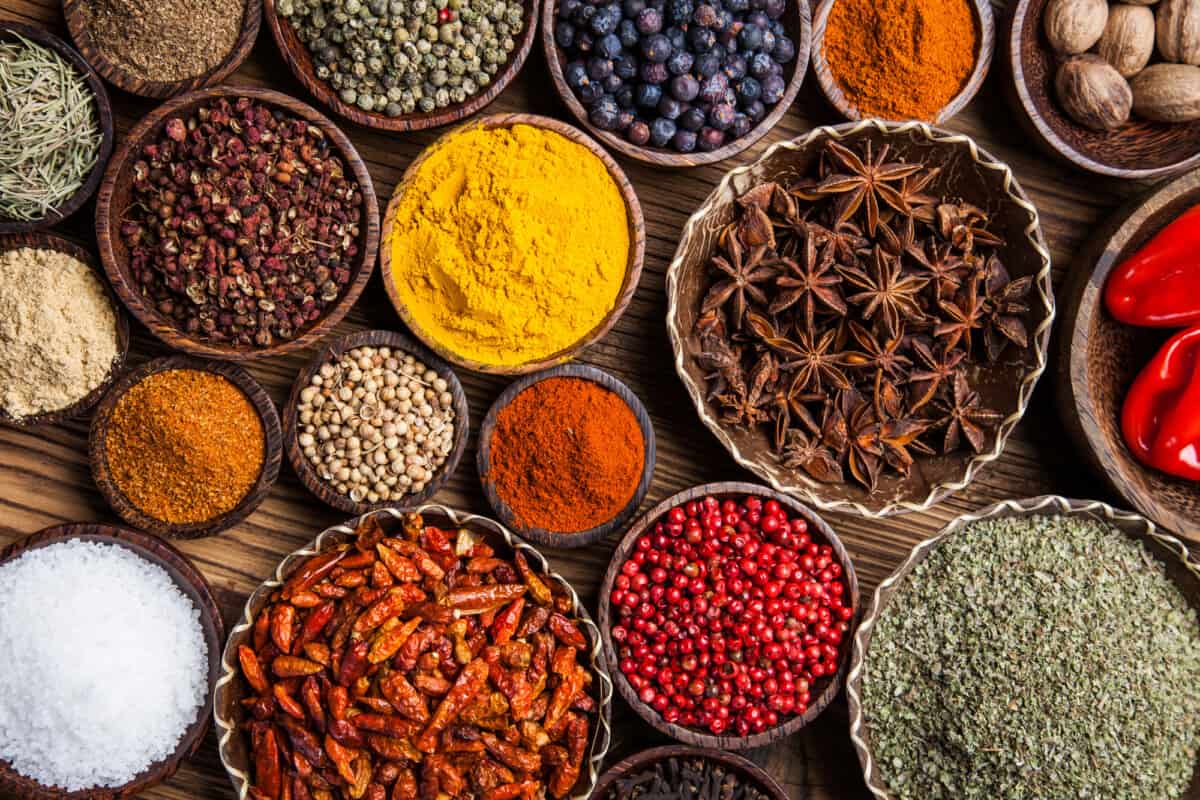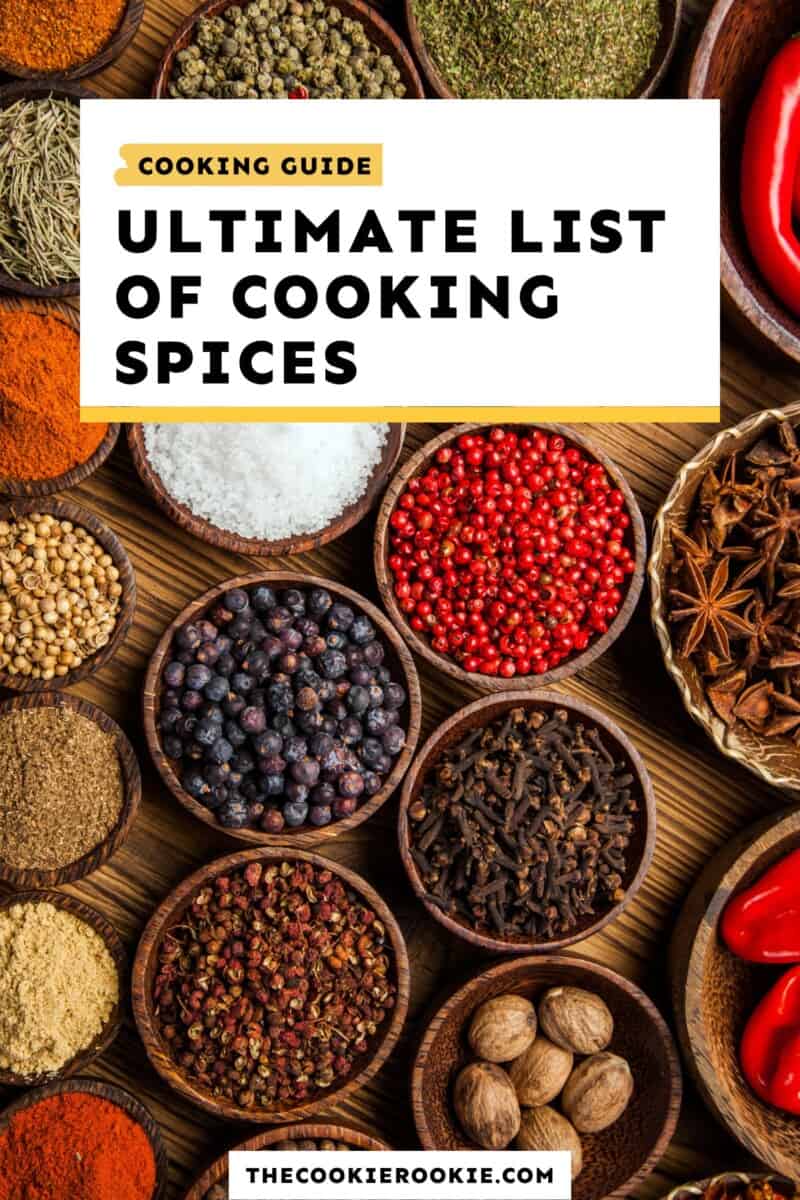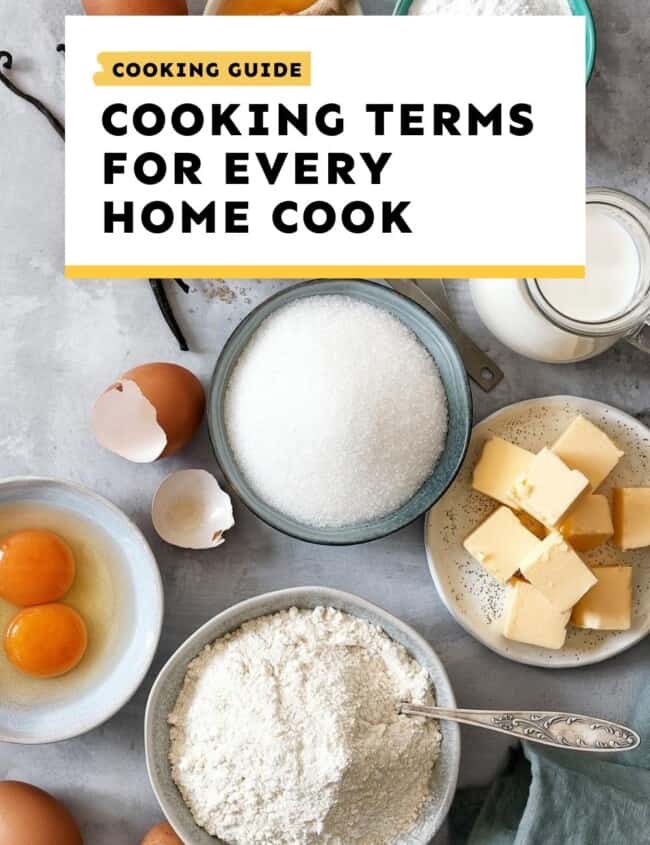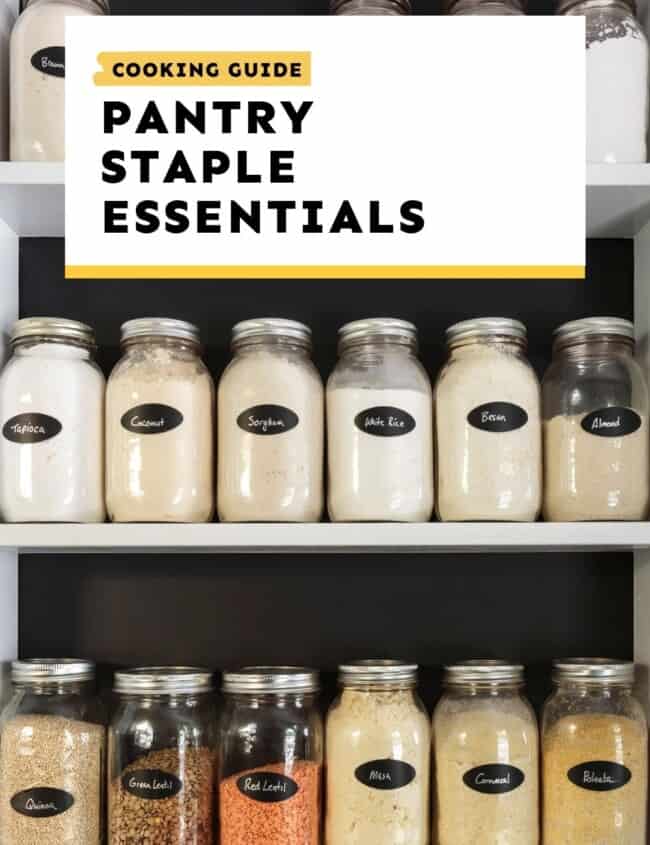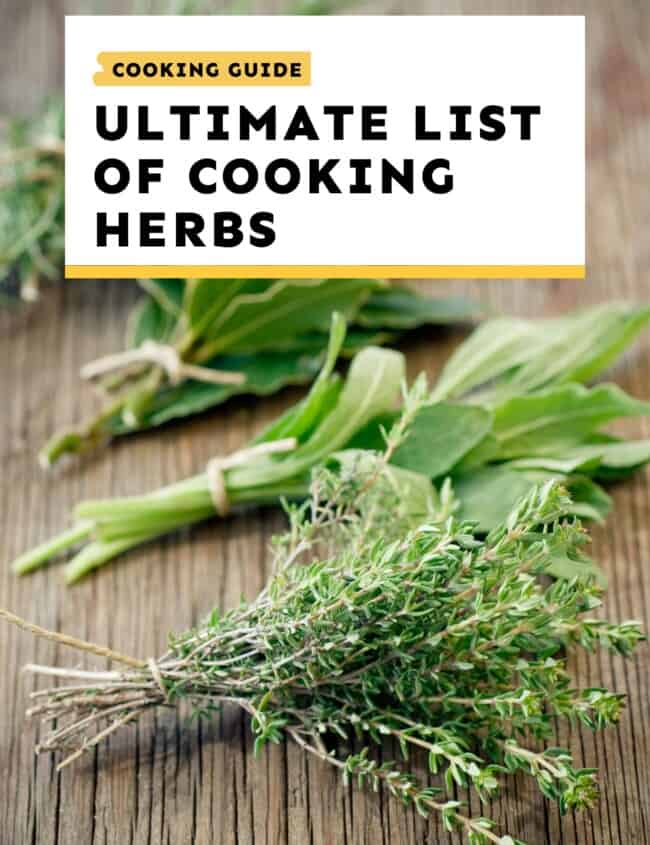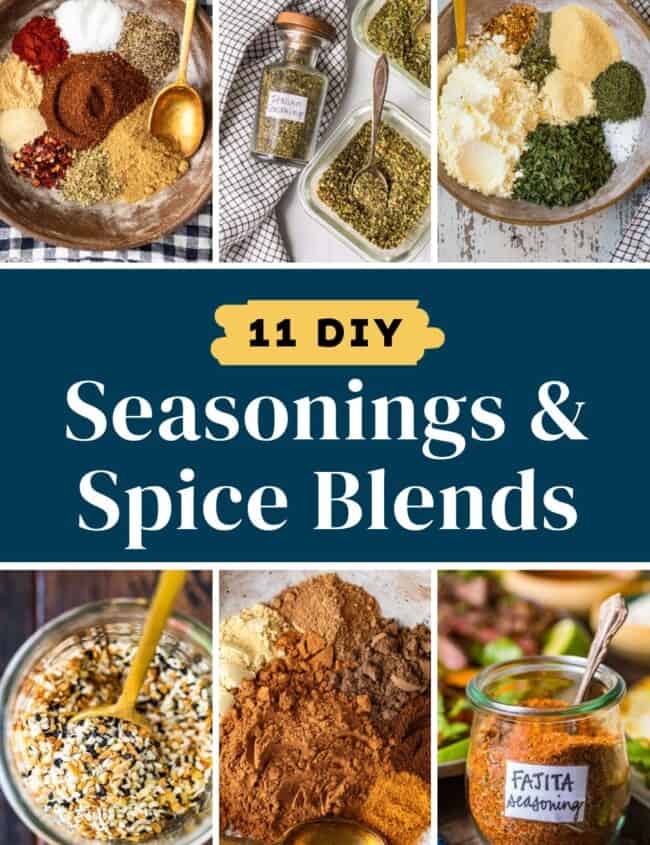This is the only list of spices you’ll ever need! Learn about all the common cooking spices and how to use them, so you can stock your kitchen with ease. Use this spice list any time you need to find the perfect one for any recipe!

This post may include affiliate links that earn us a small commission from your purchases at no extra cost to you.
List of Common Cooking Spices
Cooking spices are an important thing to stock up on in any kitchen. Along with cooking herbs, they add so much flavor to recipes of all kinds–truly the only way to make amazing food!
This essential list of spices includes all the best ones you need to have on hand to use over and over again, as well as a few extras that you might not need as often. Even better, I’m explaining every spice, what it tastes like, where it comes from, and how to use it.
So consider this your guide to spices: which ones to buy to stock your spice cabinet, and when to use them in various recipes!
What are Spices?
Spices come from various parts of different plants, including seeds, roots, and fruits. They are dried, and often ground up into a powder, although sometimes they are sold or used whole. Cooking spices are used to add flavor and color to foods.
Anything made from dried leaves, flowers, or stems would be categorized as an herb instead of a spice.
Whole Spices vs Ground Spices
You can get most spices in either the whole form or already ground up. Both types are available for purchase at various stores, and they both have their pros and cons.
- Whole Spices: These are the whole, dried form of the plant part that the spice comes from. The main benefit of using whole spices is that they have a longer shelf life. You can store them and use them long-term, and some spices are just best in this form (saffron, cinnamon sticks, and peppercorns). The downside is simply that you have to grind them down yourself, which isn’t easy to do with all spices.
- Ground Spices: These are spices that have already been ground down from the whole form, into a powder. These are the most convenient option for your spice cabinet because they’re ready to use, and they’re more potent in smaller doses. However, they lose their potency much faster than whole spices, so you’ll need to replace them regularly for best results.
Tip! If you want to substitute one for the other, just know that ground spices are more potent (as long as they’re fresh), so you may need to adjust the amount for your recipe.
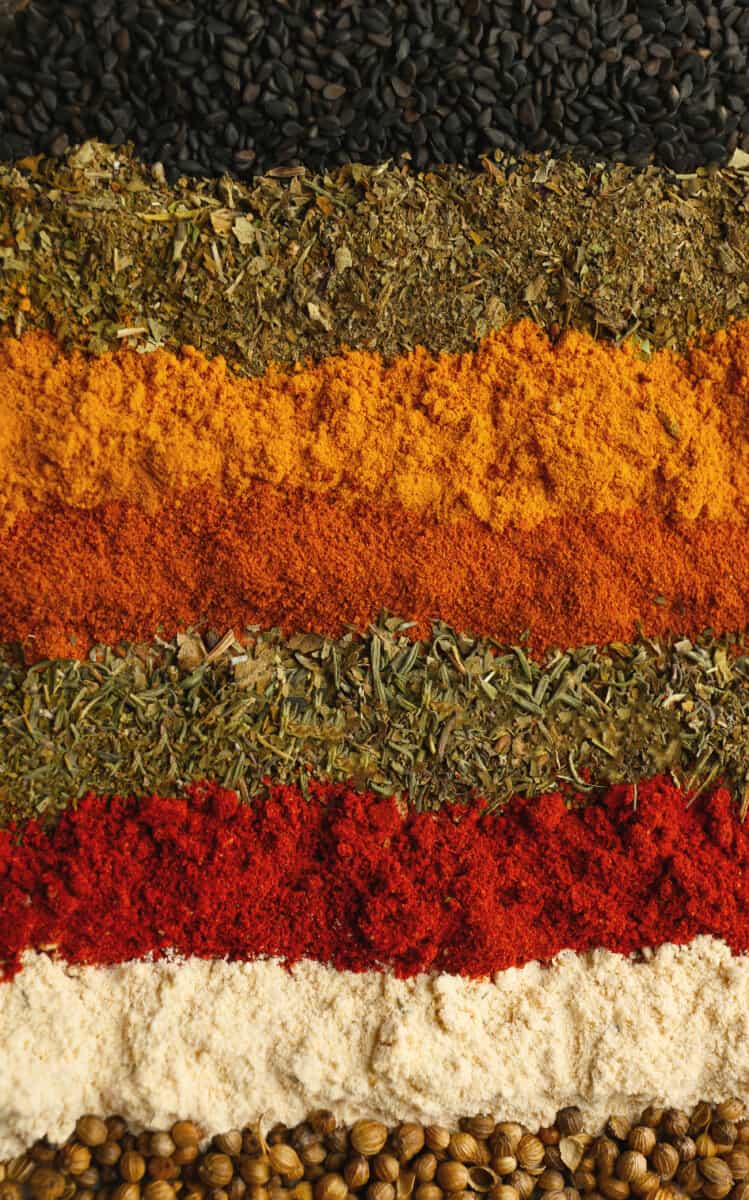

Email This Recipe
Enter your email and we’ll send the recipe directly to you!
Spices List (A-Z)
If you’re looking to stock your spice cabinet, or just wondering what all those spices even do, this list can be your guide! While you don’t necessarily need every single spice on this list, you can pick and choose which ones are most essential for your everyday cooking.
Here’s a quick look at what each spice does, when to use it, and recipes that use them!
Allspice
Although the name may have you thinking otherwise, allspice is a singular spice from a dried berry, not a combination of multiple spices. But it does have a flavor profile that tastes as if it could be a blend of cinnamon, nutmeg, and clove. It’s commonly used in Caribbean and Jamaican cooking, as well as in baked goods and desserts. You can use ground allspice or whole allspice berries.
- When to Use it: It works in both sweet and savory dishes.
- Recipes with Allspice: Spiced Rum, Homemade Carrot Cake, Spiced Rice Pilaf
Black Pepper(corn)
Black pepper is one of the most essential spices that you MUST have in your kitchen. It comes out of the plant as a peppercorn (like a tiny ball), and is then ground into a usable spice. You can find it at the store in the form of peppercorns to grind fresh (recommended), or in a pre-ground or powder form. It has a smoky heat that builds up nicely.
- When to Use it: Use it as a finishing spice to lightly season foods to taste, or build it up to get more of the smoky essence. It’s a good go-to for most any dish.
- Recipes with Black Pepper: Crockpot Salsa Chicken, Hamburger Casserole, Instant Pot Meatloaf
Caraway Seeds
Caraway seed comes from the caraway plant. Although they are called “seeds” (which they resemble), they are actually the dried fruit of the plant, not the seeds. They can be used whole or ground into a powder. They have a bitter, earthy flavor and a sharp nutty aroma. It’s popular in some European and Middle-eastern cuisines and baking. You’ll typically find it in rye bread, some German potato salads, and cabbage dishes.
- When to Use it: To add a savory, earthy twist to meat dishes, potatoes, casseroles, and stews. Toast them first to intensify the flavor.
- Recipes with Caraway: Crockpot Corned Beef and Cabbage, and it would be a great addition to this German Potato Salad.
Cardamom
Cardamom is a warm, aromatic spice with a slightly minty flavor. It’s easily grouped in with “fall” spices such as nutmeg and cloves, and is found in chai and garam masala. It’s a popular spice in Indian and South Asian cuisine. You can buy ground cardamom or use whole cardamom pods for more intense flavor.
- When to Use it: Use it in recipes for an autumn-inspired flavor, or when you want a warm spicy flavor.
- Recipes with Cardamom: Fall Sangria, Tandoori Chicken, Dairy Free Chicken Curry
Cayenne Pepper
This spice is ground up shavings of (you guessed it) a cayenne pepper. This chili pepper packs some heat, so using it in small doses as a ground spice is perfect for cooking everyday meals. You can, however, get whole peppers for more extreme spice.
- When to Use it: Use it when you want to add some heat to your recipe. It works well in Mexican dishes.
- Recipes with Cayenne Pepper: Baked Ground Beef Tacos, Honey Garlic Salmon and Asparagus, Sweet & Spicy Bacon
Cinnamon
Cinnamon comes from the inner bark of “cinnamon” trees. It’s a warm spice with a bite. It’s often combined with sugar for sweet desserts and baked goods, but it can add great flavor to savory dishes and meats as well. You can buy cinnamon sticks or ground cinnamon to use in your cooking.
- When to Use it: When you want to add a warm, sweet, rich depth of flavor. It’s especially great in baked goods, warm drinks, and spiced meat dishes.
- Recipes with Cinnamon: Homemade Cinnamon Rolls, Baked Sweet Potato, Brown Sugar Glazed Carrots
Cloves
Cloves are the flowering bud from a family of trees native to Indonesia. It is a rich, aromatic spice that adds warmth to both sweet and savory recipes. It’s great for meat dishes and sauces, as well as warm drinks and baked goods.
- When to Use it: Add just a small amount (it’s strong) for an added warmth, similar to allspice, cinnamon, or nutmeg.
- Recipes with Cloves: Soft Molasses Cookies, Marmalade Glazed Ham, Pumpkin Pie Spice
Coriander Seed
Coriander seed is the dried fruit of the coriander plant. The leaves of this plant are known as cilantro in North America, so the “seeds” used as a spice have a similar flavor profile. It adds a spicy, citrusy taste, but is more nutty than the leaves. You can toast these up to add a crunch, or use them ground up.
- When to Use it: Add it to Mexican dishes, curries, dry spice rubs, or brines.
- Recipes with Coriander Seed: Honey Glazed Chicken Wings, Shrimp Tacos with Pineapple Slaw, Mexican Tater Tot Casserole
Cumin
Cumin seeds come from a flowering plant in the parsley family. They are dried and ground up into a spice that is popular in Mexican/Tex-Mex dishes, as well as cuisines all over the world. It has an earthy, bitter heat, with a hint of sweetness that balances out nicely when cooked into recipes.
- When to Use it: To add heat to Tex-Mex dishes, curries, sauces, and more.
- Recipes with Cumin: One Pot Chili Mac, Baked Sweet Potato Fries, Instant Pot Queso Blanco
Garlic Powder
Garlic powder is a ground up version of everyone’s favorite flavor additive. Garlic bulbs are dehydrated and ground into a powder so you can easily add it to dishes in a pinch. It’s not quite as flavorful and pungent as using fresh garlic, but sometimes that works better for a recipe.
- When to Use it: Use it when you want to add a hint of garlic to your dish without overwhelming it.
- Recipes with Garlic Powder: Cheesy Garlic Cornbread, Funeral Potatoes, Honey BBQ Chicken Wings
Ginger
Ginger is a bulbous root with a zesty, pungent, aromatic flavor when used as a spice. It can be used in both sweet and savory recipes, and because of its health benefits, it’s often used in juices, soups, and other healthy dishes. It is commonly available as a ground powder, as a whole/fresh root, or crystallized (great for desserts and adding sweetness).
- When to Use it: To add a uniquely sweet but pungent bite. It’s great in sauces and marinades, as well as healthy juices.
- Recipes with Ginger: Spiced Pear Cider, Teriyaki Tofu, Ginger Cookies
Mustard Seed
Mustard seeds are the small, round (often yellow-white in color) seeds from the family of mustard plants. It adds a simple yet tangy flavor to all kinds of dishes, and makes a great addition to rubs for meats. And yes, it is used to make mustard! But it can also be used whole or ground for various recipes.
- When to Use It: Use it in dishes that need an earthy, tangy flavor. Add it to meat and poultry dishes.
- Recipes with Mustard Seed: Cauliflower with Melted Onions, Pickled Mustard Seeds
Nutmeg
Nutmeg is the seed of a certain species of evergreen tree, that is ground up to use as a spice. Mace, another spice, is made from the seed casing. Nutmeg has a nutty, almost-sweet, warm flavor that is often used in baked goods, desserts, and warm drinks. It’s also a great spice to use with roasted veggies and meat. Mace has a similar taste, but is “spicier” and more intense.
- When to Use it: Use it to add a hint of sweetness to baked goods and other recipes. It’s a great spice to use in the fall (along with cinnamon, allspice, or cardamom).
- Recipes with Nutmeg: Banana Bread Protein Balls, and Honey Glazed Carrots
Onion Powder
Onion powder is a convenient way to add flavor into your recipes without fresh onions. It’s made by dehydrating and grinding up onion (of course). It’s much more potent in this form, and adds that delicious pungency to all kinds of dishes and seasoning blends.
- When to Use it: When you don’t have onions on hand, or you want to add a more intense onion flavor. Or use it to make dry rubs and seasonings.
- Recipes with Onion Powder: Sour Cream and Onion Dip, Chicken Parmesan Casserole, Air Fryer Chicken Breast
Paprika
Paprika is made from dried and ground red peppers. It has a kick of heat, but it is not intensely spicy. You can get either sweet paprika (which is usually labeled simply as paprika) or smoked paprika (the peppers are smoked before they are ground into a powder). The smoked kind, as the name suggests, has a heavier, spicier, more intense flavor. Regular/sweet paprika is lighter and slightly sweeter.
- When to Use it: Use it to add heat to meat dishes, sides, and sauces. Smoked is ideal for BBQ, or when you need more intense flavor. Regular is ideal to add a more subtle heat to all kinds of recipes.
- Recipes with Paprika: Baked Chicken Wings, Pan Fried Tilapia, Air Fryer Jalapeno Poppers
Red Pepper Flakes
Crushed red pepper flakes are a mix of red peppers (like cayenne, bell peppers, and more) that have been dried and crushed into small flakes. It is similar to cayenne pepper, but this spice is crushed rather than ground, and contains more than just one type of pepper. It has a pretty uniform level of spice that adds heat but stays balanced.
- When to Use it: To add some heat to dishes, used as a spice or condiment. It’s often used like grated parmesan, simply sprinkled on top of pizza and pastas.
- Recipes with Red Pepper Flakes: Stuffed Pepper Soup, Garlic Bread Pizza Casserole, Easy Chicken Fajitas
Saffron
Saffron is a long and skinny, bright red spice that comes from a flowering plant. The thread-like stigma from the flower is dried to use as a spice. Its unique flavor is best described as lightly sweet, floral, and earthy. This is a more expensive spice, best bought and used whole. So this is better as a special recipe ingredient, rather than something to stock in your cabinet.
- When to Use it: When you want to add a fragrant aroma and flavor. It’s most often used in Middle-Eastern, North African, and South Asian cuisines. It’s a good addition to sweet desserts too.
- Recipes with Saffron: Lemon Saffron Salmon, Moussaka
Star Anise
Star anise comes from an evergreen tree, and it looks like a little brown star. This is the seed pod, and inside are the seeds, both of which are used as spices. It has an earthy yet sweet sort of licorice flavor, and the seeds are extra aromatic. Despite the name, this is not the same as aniseed, but they do have a similar flavor.
- When to Use it: Use it in baked goods and pastries, or warm, savory dishes.
- Recipes with Star Anise: Chai with Bourbon, Roasted Butternut Squash Soup, Instant Pot Apple Cider
Turmeric
Turmeric is a bright, golden yellow spice, most often used in a powdered form. It comes from a plant in the ginger family, so even though it tastes quite different, it has a similar pungency and many health benefits. It’s earthy and aromatic, and can be used in all kinds of dishes.
- When to Use it: When you want to add a simple, earthy flavor to food. It’s popular in Middle-Eastern and South Asian cuisines, like curries.
- Recipes with Turmeric: Vegetarian Tikka Masala, Instant Pot BBQ Ribs
Vanilla
Vanilla is a super popular spice that’s used a lot in desserts, baked goods, and other recipes. It comes from a flowering plant, and the seeds are encased in a long black pod. It’s commonly bought and used in its whole form (the long pod), but is also widely used as an extract.
- When to Use it: To add a smooth sweetness to desserts and other sweet recipes.
- Recipes with Vanilla: Peaches and Cream French Toast, Chocolate Chip Mug Cookie
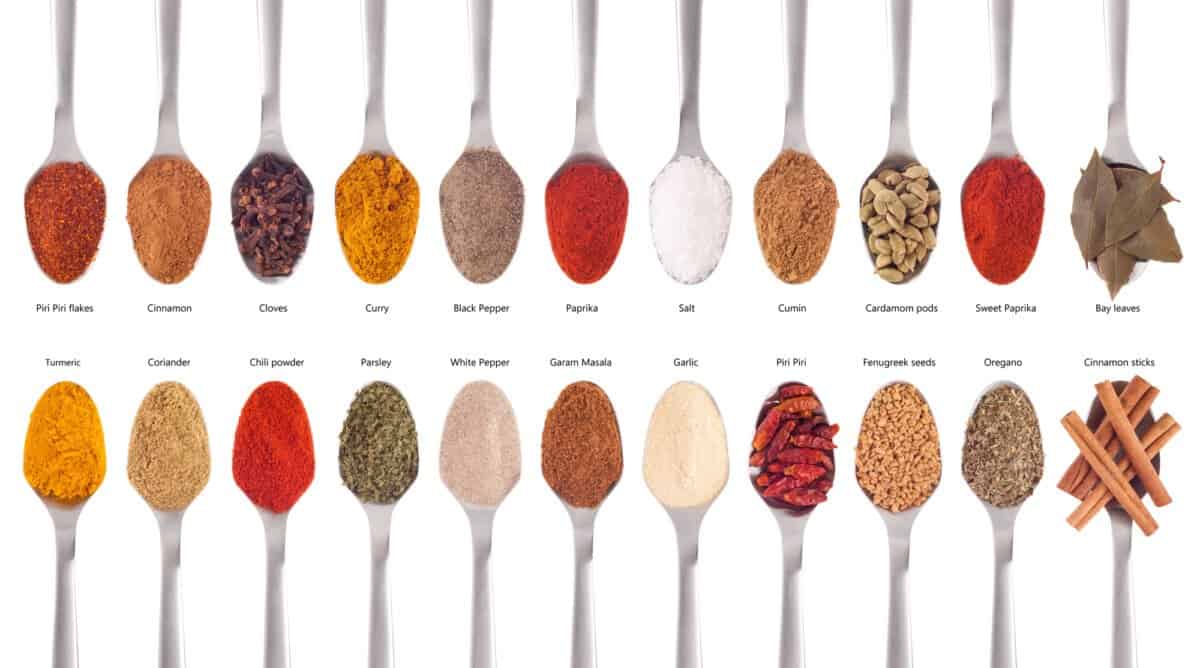
Cooking Spices List
To wrap up, here are the 20 cooking spices we covered. We definitely recommend stocking up on these for your kitchen, so you’re always ready to cook!
- Allspice
- Black Pepper
- Caraway Seeds
- Cardamom
- Cayenne Pepper
- Cinnamon
- Cloves
- Coriander Seed
- Cumin
- Garlic Powder
- Ginger
- Mustard Seed
- Nutmeg
- Onion Powder
- Paprika
- Red Pepper Flakes
- Saffron
- Star Anise
- Turmeric
- Vanilla
So many spices, so many possibilities! Now that you have this huge list of spices and know how to use them, you can stock that spice cabinet and have everything you need on hand. And you can start experimenting a bit more with your cooking, and always get the flavor you want!
Cooking Guides
Learn more about stocking your kitchen and basic cooking skills, so you’ll be ready to cook anything you like!
